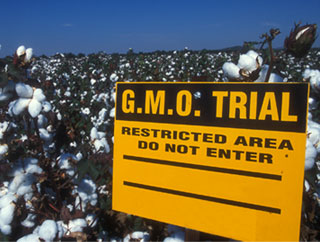Scientist: GM technology has exacerbated pesticide treadmill in India
By Ken Roseboro
Published: February 1, 2012
Category: GM Food Environmental Risks

To access all the articles in this month's issue of The Organic & Non-GMO Report, SUBSCRIBE NOW.
Glenn Davis Stone is a professor of anthropology and environmental studies at Washington University in St. Louis, Missouri. His research has focused on the operation of small farms for the last 30 years, focusing on sustainability, social organization of labor, settlement patterns, land conflict, indigenous knowledge, and intensification. Since 2000, Dr. Stone has focused his research on agricultural biotechnology and small farms. His primary field study has been the cotton belt of India, since genetically modified Bt cotton is India's first GM crop.
He says, “I am not an opponent or proponent of GM crops, and I have been quite critical of ‘scientists’ who act like activists on both sides of the issue.”
There are a wide range of opinions about the impact of genetically modified cotton on farmer suicides in India. GM proponents say suicides began before the introduction of GM cotton, while opponents blame Monsanto and the introduction of GM cotton seeds for the suicides. Where do you think the truth lies?
GDS: The biggest spike in farmer suicides was in 1998; this is well documented and received world attention (Wall Street Journal, St. Louis Post-Dispatch, and other media outlets). This was four years before Bt cotton was released. There is a solid study by economists at IFPRI (International Food Policy Research Institute) showing that suicides have not gone up with the spread of Bt cotton. As I have said in my articles, both sides of the debate are willing to use the suicide tragedy to further their own ends.
The same can be said about the success of GM cotton in India. GM crop supporters say GM cotton has been a huge success in India, while detractors say it isn’t. What is your opinion?
GDS: The question is impossible to answer simply or well. It is well documented that yields have been going up since Bt cotton was released in 2002. GMO enthusiasts routinely make statements implying that Bt cotton should get credit for any increase after 2002. But as I show in my recent World Development article, yields were on their way up anyway; 2002 was an unusually low point in cotton yields. By far the biggest jump in yields was between 2002-2003 and 2003-2004, which some cite as evidence that Bt cotton had an immediate impact, but only 1.3% of the cotton planted in 2003-2004 was Bt! Also, cotton yields have been declining every year since 2007. So while the net effect is a significant rise, the trend has been up sharply then down steadily.
Has Bt cotton reduced pesticide use in India?
GDS: Yes, but that’s not all there is to it. Cotton farmers were spraying ridiculous amounts of pesticide 10-15 years ago. Those with a vested interest in GM seeds will tell you the problem was bollworms, but cotton farmers have always dealt with insect problems. I would say the real problem was they were suffering from agricultural deskilling. I describe this in my published articles, but the gist of it is increasing reliance on rapidly-changing, “opaque” technologies. Introducing Bt cotton appears to be lowering pesticide use while increasing deskilling: curing a symptom while exacerbating the underlying cause.
You have said that GM technology has exacerbated the pesticide treadmill problem. Why has that happened?
GDS: I would say it has exacerbated the technology treadmill. From a rapid procession of pesticide sprays we have gone to a rapid procession of gene constructs. The way that cotton entomology works is that there are two major classes of insect pests: bollworms and sucking pests. Bt cotton is designed to kill bollworms. Within a few years of its introduction, some bollworms were starting to show resistance; Monsanto actually reported this. To date it has not developed into a major problem, but most people believe it eventually will. In the meantime, there have been surges in populations of sucking pests. The same thing happened in China. So the use of insecticide sprays for sucking pests has been going up. As of a few years ago, there was still a net reduction in pesticide use, but the trends are disturbing. And Monsanto tells us they will keep providing new genes in the cotton; we can count on them. That is a treadmill. There is a lot of money to be made on unsustainability!
You’ve discussed Bt cotton as a craze or fad. What is causing this? Are farmers buying the seeds because they see others buy it and feel they need to in order to succeed?
GDS: Well now farmers buy Bt seeds because they have little choice—it is very hard to find non-GM seeds any more. My research shows that with rapidly-changing, “opaque” seed technologies, farmers have a harder and harder time predicting the performance of seeds, and they turn increasingly to emulation. Of course emulation always plays some role in agricultural decision-making, but it has to be based on actual assessments. Careful records of seed choices in a large number of villages over several years show that villages tend to have fads.
In general what is the cost of Bt cotton seed compared to non-Bt cotton seed in India?
GDS: Initially it cost four times as much in most areas, but with government intervention this dropped to about twice the cost of conventional a few years ago.
In the US, I’ve heard reports from seed companies and farmers that varieties of non-GMO soybean and corn seed are becoming harder to find, leaving farmers with less choice and causing them to buy GM seed. Do you see this happening in India also?
GDS: With cotton, definitely. There is still a market for non-GM corn and soybean seed in the US for several reasons. One is that some Asian countries have been willing to pay a premium for non-GM crops.
© Copyright The Organic & Non-GMO Report, February 2012




